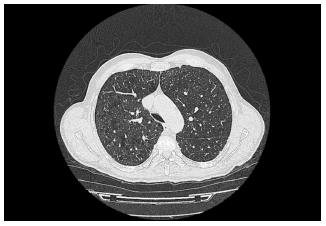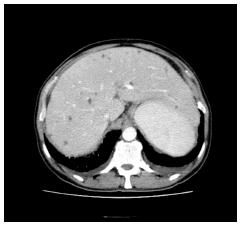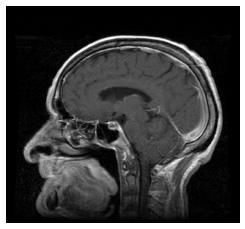Published online Jul 16, 2014. doi: 10.12998/wjcc.v2.i7.301
Revised: April 19, 2014
Accepted: April 25, 2014
Published online: July 16, 2014
Intravesical bacillus Calmette-Guerin (BCG) instillation has been adopted for the treatment of patients with superficial bladder cancer. Severe adverse events due to local instillation of BCG are uncommon, with an overall rate of serious complications of less than 5%. We report the case of an immunocompetent adult patient with multi-system effects, namely pneumonitis, granulomatous hepatitis and meningitis, who responded well to standard treatment for Mycobacterium bovis. This case highlights the importance of a thorough assessment of this type of patient.
Core tip: Intravesical instillation of bacillus Calmette-Guerin (BCG) is a therapeutic option in bladder cancer. Multi-system effects are a rare complication of this procedure, and certain aspects concerning its diagnosis and treatment are unclear. We report the case of a patient who developed effects on multiple organs after intravesical BCG instillations, and we review current knowledge concerning the diagnosis and management of BCG infection.
-
Citation: Marquez-Batalla S, Fraile-Villarejo E, Belhassen-García M, Gutierrez-Zubiaurre N, Cordero-Sánchez M. Disseminated infection due to
Mycobacterium bovis after intravesical BCG instillation. World J Clin Cases 2014; 2(7): 301-303 - URL: https://www.wjgnet.com/2307-8960/full/v2/i7/301.htm
- DOI: https://dx.doi.org/10.12998/wjcc.v2.i7.301
Intravesical administration of bacillus Calmette-Guerin (BCG) is an essential tool in the treatment of superficial bladder carcinoma in situ[1]. This approach is generally well tolerated, although it occasionally leads to severe local and/or systemic complications[2]. The most serious complications of intravesical BCG instillation are related to disseminated infection. When disseminated BCG infection occurs, antituberculous therapy with or without glucocorticoids should be administered. We report a case of disseminated infection due to intravesical BCG instillations, resulting in pneumonitis, granulomatous hepatitis and meningitis.
We present the case of a 64-year-old male patient with a history of urothelial vesical neoplasm, benign prostatic hyperplasia and chronic obstructive pulmonary disease. He was being treated with tamsulosin, tiotropium bromide and salbutamol. Six months before, he had received six weekly doses of intravesical BCG instillation as an induction treatment, and one month before, he had started maintenance therapy with three doses per week. At the time of presentation, he reported weakness, weight loss and a slight fever with three weeks of evolution. Physical examination revealed hepatosplenomegaly. An analysis showed hepatic cholestasis (alkaline phosphatase 358 U/L, gamma-glutamyl transpeptidase 306 U/L), lactate dehydrogenase (LDH) 547 U/L and C-reactive protein 1.27 mg/dL. A complete blood count and urine sediment were normal. A thoracic X-ray showed multiple micronodular opacities. A thoraco-abdominal CT scan revealed a pulmonary micronodular pattern, hepatic granulomas and hepatosplenomegaly (Figures 1 and 2). Blood and urine cultures for bacteria were negative, as was a serological analysis (for HIV, HBV, HCV and Treponema pallidum). The urinalysis was positive for the species Mycobacterium tuberculosis, and Mycobacterium bovis (M. bovis) BCG grew with resistance to cycloserine and pyrazinamide. A genetic study detected the pnc A C169G (H57D) mutation, and we identified the species as M. bovis. The patient started treatment with isoniazid, rifampicin and ethambutol. After one week of treatment, the patient showed dizziness and instability while standing still and walking. The cerebrospinal fluid (CSF) showed red blood cells 4500/μL, leukocytes 16 μL (polymorphonuclear 25%, mononuclear 75%), proteins 82 mg/mL, glucose 67 mg/mL (capillary glycemia 144 mg/dL), LDH: 35 IU/L and adenosine deaminase 5.6 U/L (0-5). Magnetic resonance imaging of the brain (Figure 3) showed thickening and linear meningeal enhancement. Microbiological analysis of the CSF was negative. Given the meningeal involvement, anti-tuberculosis treatment was administered for one year, with good clinical and radiological responses.
The adverse effects of intravesical BCG instillations can appear early or several years after the treatment. Although there are certain common local effects, such as cystitis (91%)[3] (this condition can be difficult to differentiate from other urinary tract infections), systemic complications are rare. The frequency of appearance ranges from 2.9% in cases with fever to 0.3% in cases with skin exanthema[4]. The most severe symptoms are pneumonitis, hepatitis, sepsis and pancytopenia. No differences in the incidence of complications were observed when comparing different BCG preparations or doses[5]. The spreading mechanism is not exhaustively known. Certain authors think that hematogenous spread occurs from the bladder[3], whereas others believe that the spread is due to a type IV hypersensitivity-related mechanism[6]. The response to glucocorticoids administered along with antituberculous drugs has also supported the notion of a hypersensitivity response. There are no established effective measures to prevent a disseminated infection with BCG[7], although the risk increases when instillations are temporally close to surgery or to traumatic catheterization[8]. The genetic study of the urine sample of our patient allowed us to identify M. bovis and to confirm its classic resistance profile. Given the meningeal involvement in the patient in our case, the treatment was extended for one year, with combination with corticoids in the first weeks.
In conclusion, intravesical BCG instillation can induce disseminated infection. Molecular techniques can help in early diagnosis because a delay in management can be lethal. In our patient, standard triple therapy with steroids led to complete recovery.
A 64-year-old male patient with an urothelial-vesical neoplasm treated by intravesical bacillus Calmette-Guerin (BCG) instillations.
Hepatosplenomegaly and later dizziness and instability.
Neoplasm and central nervous system infection.
Alkaline phosphatase 358 U/L, gamma-glutamyl transpeptidase 306 U/L, lactate dehydrogenase 547 U/L and C-reactive protein 1.27 mg/dL. A complete blood count and urine sediment were normal.
A thoracic X-ray showed multiple micronodular opacities. A thoraco-abdominal computed tomography scan revealed a pulmonary micronodular pattern, hepatic granulomas and hepatosplenomegaly. Magnetic resonance imaging of the brain showed thickening and linear meningeal enhancement.
A urinalysis was positive for Mycobacterium bovis.
Anti-tuberculosis treatment was administered for one year.
Severe adverse events due to local instillation of BCG are uncommon, and disseminated BCG infection can simulate several diseases.
BGG is a low-virulence mycobacterium that originates from successive cultures of Mycobacterium bovis. Pnc A is a gene encoding the mycobacterial enzyme pyrazinamidase.
BCG can induce disseminated disease with multi-system failure.
This paper reports the case of serious complications in a variety of organs after intravesical BCG instillation. The manuscript is basically well written.
P- Reviewers: Hsu WH, Nagata T S- Editor: Song XX L- Editor: A E- Editor: Wu HL
| 1. | Malmström PU, Sylvester RJ, Crawford DE, Friedrich M, Krege S, Rintala E, Solsona E, Di Stasi SM, Witjes JA. An individual patient data meta-analysis of the long-term outcome of randomised studies comparing intravesical mitomycin C versus bacillus Calmette-Guérin for non-muscle-invasive bladder cancer. Eur Urol. 2009;56:247-256. [PubMed] [DOI] [Cited in This Article: ] |
| 2. | McParland C, Cotton DJ, Gowda KS, Hoeppner VH, Martin WT, Weckworth PF. Miliary Mycobacterium bovis induced by intravesical bacille Calmette-Guérin immunotherapy. Am Rev Respir Dis. 1992;146:1330-1333. [PubMed] [DOI] [Cited in This Article: ] |
| 3. | Gonzalez OY, Musher DM, Brar I, Furgeson S, Boktour MR, Septimus EJ, Hamill RJ, Graviss EA. Spectrum of bacille Calmette-Guérin (BCG) infection after intravesical BCG immunotherapy. Clin Infect Dis. 2003;36:140-148. [PubMed] [DOI] [Cited in This Article: ] |
| 4. | Miranda S, Verdet M, Héron F, Vittecoq O, Levesque H, Marie I. [Acute reactive arthritis after intravesical instillation of bacillus Calmette-Guérin. Two case reports and literature review]. Rev Med Interne. 2010;31:558-561. [PubMed] [DOI] [Cited in This Article: ] |
| 5. | Lamm DL. Efficacy and safety of bacille Calmette-Guérin immunotherapy in superficial bladder cancer. Clin Infect Dis. 2000;31 Suppl 3:S86-S90. [PubMed] [DOI] [Cited in This Article: ] |
| 6. | Elkabani M, Greene JN, Vincent AL, VanHook S, Sandin RL. Disseminated Mycobacterium bovis after intravesicular bacillus calmette-Gu rin treatments for bladder cancer. Cancer Control. 2000;7:476-481. [PubMed] [Cited in This Article: ] |
| 7. | Damiano R, De Sio M, Quarto G, Di Lorenzo G, Perdonà S, Palumbo IM, Azzarito G, Giugliano F, Autorino R. Short-term administration of prulifloxacin in patients with nonmuscle-invasive bladder cancer: an effective option for the prevention of bacillus Calmette-Guérin-induced toxicity? BJU Int. 2009;104:633-639. [PubMed] [DOI] [Cited in This Article: ] |
| 8. | Nadasy KA, Patel RS, Emmett M, Murillo RA, Tribble MA, Black RD, Sutker WL. Four cases of disseminated Mycobacterium bovis infection following intravesical BCG instillation for treatment of bladder carcinoma. South Med J. 2008;101:91-95. [PubMed] [DOI] [Cited in This Article: ] |











